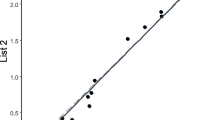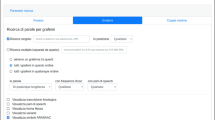Abstract
Speech perception scores are widely used to assess patient’s functional hearing, yet most linguistic material used in these audiometric tests dates to before the availability of large computerized linguistic databases. In an ENT clinic population of 120 patients with median hearing loss of 43-dB HL, we quantified the variability and the sensitivity of speech perception scores to hearing loss, measured using disyllabic word lists, as a function of both the number of ten-word lists and type of scoring used (word, syllables or phonemes). The mean word recognition scores varied significantly across lists from 54 to 68%. The median of the variability of the word recognition score ranged from 30% for one ten-word list down to 20% for three ten-word lists. Syllabic and phonemic scores showed much less variability with standard deviations decreasing by 1.15 with the use of syllabic scores and by 1.45 with phonemic scores. The sensitivity of each list to hearing loss and distortions varied significantly. There was an increase in the minimum effect size that could be seen for syllabic scores compared to word scores, with no significant further improvement with phonemic scores. The use of at least two ten-word lists, quoted in syllables rather than in whole words, contributed to a large decrease in variability and an increase in sensitivity to hearing loss. However, those results emphasize the need of using updated linguistic material for clinical speech score assessments.




Similar content being viewed by others
References
Wilson RH, McArdle R (2005) Speech signals used to evaluate functional status of the auditory system. J Rehabil Res Dev 42:79. doi:10.1682/JRRD.2005.06.0096
Metselaar M, Maat B, Krijnen P et al (2008) Comparison of speech intelligibility in quiet and in noise after hearing aid fitting according to a purely prescriptive and a comparative fitting procedure. Eur Arch Otorhinolaryngol 265:1113–1120. doi:10.1007/s00405-008-0596-x
Moon IJ, Kim EY, Jeong JO et al (2012) The influence of various factors on the performance of repetition tests in adults with cochlear implants. Eur Arch Otorhinolaryngol 269:739–745. doi:10.1007/s00405-011-1699-3
Gelfand SA (2001) Essentials of audiology. Thieme, New York
Hudgins CV, Hawkins JE (1947) The development of recorded auditory tests for measuring hearing loss for speech. Laryngosc 57:57–89
Miller GA, Heise GA, Lichten W (1951) The intelligibility of speech as a function of the context of the test materials. J Exp Psychol 41:329
Fournier J-E (1951) Audiométrie vocale: les épreuves d’intelligibilité et leurs applications au diagnostic, à l’expertise et à la correction prothétique des surdités. Maloine, Paris, France
Lafon J-C (1964) Le Test phonétique et la mesure de l’audition. Dunod, Paris
Legent F, Bordure P, Calais C et al (2011) Audiologie pratique, audiométrie. Elsevier, Masson
Marian V, Bartolotti J, Chabal S, Shook A (2012) CLEARPOND: cross-linguistic easy-access resource for phonological and orthographic neighborhood densities. PLoS One 7:e43230. doi:10.1371/journal.pone.0043230
New B, Pallier C, Brysbaert M, Ferrand L (2004) Lexique 2: a new French lexical database. Behav Res Methods Instrum Comput J Psychon Soc Inc 36:516–524
Brysbaert M, New B (2009) Moving beyond Kučera and Francis: a critical evaluation of current word frequency norms and the introduction of a new and improved word frequency measure for American English. Behav Res Methods 41:977–990. doi:10.3758/BRM.41.4.977
Luce PA, Pisoni DB (1998) Recognizing spoken words: the neighborhood activation model. Ear Hear 19:1
Meyer TA, Pisoni DB (1999) Some computational analyses of the PBK test: effects of frequency and lexical density on spoken word recognition. Ear Hear 20:363–371
Moulin A, Richard C (2015) Lexical influences on spoken spondaic word recognition in hearing-impaired patients. Front Neurosci 9:476. doi:10.3389/fnins.2015.00476
Dillon H (1982) A quantitative examination of the sources of speech discrimination test score variability. Ear Hear 3:51–58
Gelfand SA (1998) Optimizing the reliability of speech recognition scores. J Speech Lang Hear Res JSLHR 41:1088–1102
Schlauch RS, Anderson ES, Micheyl C (2014) A demonstration of improved precision of word recognition scores. J Speech Lang Hear Res 57:543–555. doi:10.1044/2014_JSLHR-H-13-0017
HAS Haute autorité de santé (2007) Traitement de la surdité par pose d’implants cochléaires ou d’implants du tronc cérébral. http://www.has-sante.fr/portail/jcms/r_1498772/fr/traitement-de-la-surdite-par-pose-d-implants-cochleaires-ou-d-implants-du-tronc-cerebral (last accessed the 9th of September 2016)
Blamey PJ, Maat B, Başkent D et al (2015) A retrospective multicenter study comparing speech perception outcomes for bilateral implantation and bimodal rehabilitation. Ear Hear 36:408–416. doi:10.1097/AUD.0000000000000150
Lenarz T, James C, Cuda D et al (2013) European multi-centre study of the Nucleus Hybrid L24 cochlear implant. Int J Audiol 52:838–848. doi:10.3109/14992027.2013.802032
Mosnier I, Felice A, Esquia G et al (2013) New cochlear implant technologies improve performance in post-meningitic deaf patients. Eur Arch Otorhinolaryngol 270:53–59. doi:10.1007/s00405-011-1918-y
BIAP International bureau for audiophonology Audiometric Classification of Hearing Impairments. http://www.biap.org/en/recommandation/recommendations-pdf (accessed the 9th September 2016)
Cohen J (1992) A power primer. Psychol Bull 112:155–159. doi:10.1037/0033-2909.112.1.155
Thornton AR, Raffin MJ (1978) Speech-discrimination scores modeled as a binomial variable. J Speech Hear Res 21:507–518
Alfelasi M, Piron JP, Mathiolon C et al (2013) The transtympanic promontory stimulation test in patients with auditory deprivation: correlations with electrical dynamics of cochlear implant and speech perception. Eur Arch Otorhinolaryngol 270:1809–1815. doi:10.1007/s00405-012-2125-1
Rumeau C, Frère J, Montaut-Verient B et al (2015) Quality of life and audiologic performance through the ability to phone of cochlear implant users. Eur Arch Otorhinolaryngol 272:3685–3692. doi:10.1007/s00405-014-3448-x
Vincent C, Renard C, Blond S, Lejeune J-P (2012) Auditory evaluation in the management of acoustic neurinoma. Neurochirurgie 58:282–286. doi:10.1016/j.neuchi.2012.05.008
Goldinger SD (1996) Auditory lexical decision. Lang Cogn Process 11:559–568
Savin HB (1963) Word-Frequency Effect and Errors in the Perception of Speech. J Acoust Soc Am 35:200–206. doi:10.1121/1.1918432
New B, Brysbaert M, Veronis J, Pallier C (2007) The use of film subtitles to estimate word frequencies. Appl Psycholinguist 28:661
Brysbaert M, Buchmeier M, Conrad M et al (2011) The word frequency effect: a review of recent developments and implications for the choice of frequency estimates in German. Exp Psychol 58:412–424. doi:10.1027/1618-3169/a000123
Dirks DD, Takayanagi S, Moshfegh A et al (2001) Examination of the neighborhood activation theory in normal and hearing-impaired listeners. Ear Hear 22:1–13
Di Berardino F, Forti S, Mattei V et al (2010) Non-verbal visual reinforcement affects speech audiometry in the elderly. Eur Arch Oto-Rhino-Laryngol 267:1367–1370. doi:10.1007/s00405-010-1254-7
Löhler J, Akcicek B, Wollenberg B et al (2015) Results in using the Freiburger monosyllabic speech test in noise without and with hearing aids. Eur Arch Otorhinolaryngol 272:2135–2142. doi:10.1007/s00405-014-3039-x
Harris RW, Nissen SL, Pola MG et al (2007) Psychometrically equivalent Russian speech audiometry materials by male and female talkers: materiales de logoaudiometría en ruso psicométricamente equivalentes para hablantes masculinos y femeninos. Int J Audiol 46:47–66
Iliadou V, Fourakis M, Vakalos A et al (2006) Bi-syllabic, Modern Greek word lists for use in word recognition tests. Int J Audiol 45:74–82. doi:10.1080/14992020500376529
Han D, Wang S, Zhang H et al (2009) Development of Mandarin monosyllabic speech test materials in China. Int J Audiol 48:300–311. doi:10.1080/14992020802607456
Wang S, Mannell R, Newall P et al (2007) Development and evaluation of Mandarin disyllabic materials for speech audiometry in China. Int J Audiol 46:719–731. doi:10.1080/14992020701558511
Nissen SL, Harris RW, Channell RW et al (2011) The development of psychometrically equivalent Cantonese speech audiometry materials. Int J Audiol 50:191–201. doi:10.3109/14992027.2010.542491
van Heuven WJB, Mandera P, Keuleers E, Brysbaert M (2014) SUBTLEX-UK: a new and improved word frequency database for British English. Q J Exp Psychol 67:1176–1190. doi:10.1080/17470218.2013.850521
Vega FC, Nosti MG, Gutiérrez AB, Brysbaert M (2011) SUBTLEX-ESP: spanish word frequencies based on film subtitles. Psicológica Rev Metodol Psicol Exp 32:133–143
Moulin A, Richard C (2016) Sources of variability of speech, spatial, and qualities of hearing scale (SSQ) scores in normal-hearing and hearing-impaired populations. Int J Audiol 55:101–109. doi:10.3109/14992027.2015.1104734
Moulin A, Richard C (2016) Validation of a French-Language Version of the Spatial Hearing Questionnaire, Cluster Analysis and Comparison with the Speech, Spatial, and Qualities of Hearing Scale. Ear Hear 37:412–423. doi:10.1097/AUD.0000000000000269
Akeroyd MA, Arlinger S, Bentler RA et al (2015) International Collegium of Rehabilitative Audiology (ICRA) recommendations for the construction of multilingual speech tests: ICRA Working Group on Multilingual Speech Tests. Int J Audiol 54(Suppl 2):17–22. doi:10.3109/14992027.2015.1030513
Kollmeier B (2015) Overcoming language barriers: matrix sentence tests with closed speech corpora. Int J Audiol 54:1–2. doi:10.3109/14992027.2015.1074295
Acknowledgements
This work was supported in part by the “Fondation de l’Avenir/VISAUDIO” VI4-001 research program, by the LABEX CELYA (ANR-11-LABX-0060), the LABEX CORTEX (ANR-11-LABX-0042) of Université de Lyon, within the program “Investissements d’Avenir” (ANR-11-IDEX-0007) operated by the French National Research Agency (ANR).
Author information
Authors and Affiliations
Corresponding author
Ethics declarations
The present data were retrospectively and anonymously obtained from the audiological data of patients routinely seen at our ENT clinic for an audiological assessment.
Conflict of interest
All authors of the present publication disclose any financial or personal relationships that may be considered as a potential conflict of interest.
Rights and permissions
About this article
Cite this article
Moulin, A., Bernard, A., Tordella, L. et al. Variability of word discrimination scores in clinical practice and consequences on their sensitivity to hearing loss. Eur Arch Otorhinolaryngol 274, 2117–2124 (2017). https://doi.org/10.1007/s00405-016-4439-x
Received:
Accepted:
Published:
Issue Date:
DOI: https://doi.org/10.1007/s00405-016-4439-x




